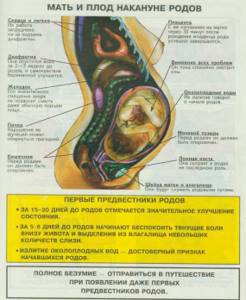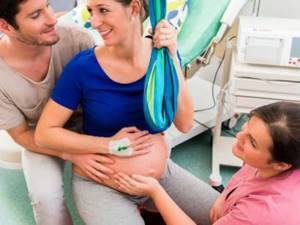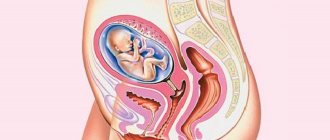Signs of labor - by the end of the fortieth week, all expectant mothers begin to prepare for a trip to the maternity hospital and are afraid of not noticing the symptoms of impending labor. This fear is present in most women who are going to become a mother for the first time. However, you should not be afraid of this, since there are many signs indicating that you will soon meet the long-awaited baby.
[Hide]
Signs of labor: Physiological symptoms
Typically, changes in the female body associated with childbirth occur first at the hormonal level. It “checks” the readiness of the uterus and placenta for the birth of a baby, as well as the child himself and his vital systems that will be responsible for his life and health after birth. If all these systems together with the fetus are ready, then labor begins.
Signs of labor in the case of normal gestation begin to appear from the thirty-eighth to thirty-ninth week, but for some expectant mothers they appear much earlier.
In first-time mothers, signs of labor may appear several weeks before the birth of the child, or several days before. Expectant mothers, for whom labor is not the first, may notice its approach even a few hours before the birth of the baby, for this reason they should be on alert starting from the thirty-ninth week. Gynecologists even advise them to spend the last few weeks in the hospital so as not to miss the onset of labor.
Sagging belly
This sign was a harbinger of imminent childbirth several centuries ago.
It is based on the fact that in this way the body prepares for labor and the birth of a baby. When a baby turns head down in the womb, sinking into the pelvis, this leads to prolapse of the abdomen. Together with it, the upper part of the uterus also descends into the pelvic floor, ceasing to put pressure on the stomach, lungs, bladder and other organs. A woman may not always be able to notice her abdominal prolapse on her own. But she will definitely feel that it has become easier for her to breathe, there is no shortness of breath when actively walking, and the heartburn that usually haunts her in recent months has disappeared.
Protrusion of the navel and strong stretching of the skin on the abdomen indicate prolapse of the abdomen before childbirth. At this stage, without proper skin care, the majority of stretch marks appear during the entire pregnancy.
Frequent trips to the toilet and characteristic changes in bowel movements
These two symptoms are explainable from a physiological point of view. Since the baby’s head drops into the pelvic area, it begins to put a lot of pressure on the expectant mother’s urinary tract, as a result of which it decreases and its volume fills much faster, leading to frequent urination. The woman begins to notice that although she visits the toilet more often, the volume of urine excreted is significantly less than before.
Due to the strong pressure of the enlarged uterus on the lower intestine, pregnant women often experience constipation. And before childbirth, on the contrary, oxytocin levels sharply increase, which leads to relaxation of the intestines and possible diarrhea. If the expectant mother notices such a pattern, then she should begin to prepare for the birth of the baby.
Unpleasant sensations in the abdominal and lumbar region
Before the baby is born, in order to move it more comfortably through the birth canal, the ligaments in the uterus stretch, the cartilage tissue softens, and the pelvic bones move apart, which leads to discomfort and, for some expectant mothers, pain.
Changes in gait and posture also occur. Many women experience pain in the pubic area, which is caused by the pressure of the child on the pelvic bones.
The appearance of false contractions
Training contractions usually make themselves felt starting from the thirty-sixth week of gestation and occur from time to time until the birth of the child. The closer the birth gets, the more often the uterus is in good shape. Expectant mothers feel as if the uterus is hardening. This condition manifests itself in nagging pain in the abdominal region or lower back; less commonly, encircling pain occurs from the lower back to the pubic bone.
The intensity of the pain can be compared to that which occurs during menstrual flow. If we compare regular contractions with training contractions, the latter last about a minute and are not distinguished by regularity. False contractions have another feature, which manifests itself in their disappearance after rest or change of body position. They do not lead to dilation of the cervix, but they allow you to speed up its preparation and train the muscles, preparing them for future intense contractions that will be necessary for normal labor.
The occurrence of false contractions should be reported to the gynecologist in charge of the pregnancy. Thanks to these symptoms, the cervix is prepared for changes and stretching. These important processes in labor are influenced by estrogen, which not only opens the cervix, but also shortens it. It becomes soft and opens by one centimeter. In obstetric practice, this condition is called one finger dilatation. Despite the fact that this sign can only be determined by a gynecologist when examining a woman in a chair, you should not miss this important symptom.
Increased discharge intensity
Before the baby is born, the expectant mother may notice a whitish, semi-liquid secretion, which is a signal that the mucus plug will soon begin to come off. Many women are afraid that the discharge has become liquid due to leakage of amniotic fluid. However, such a problem arises very rarely, and only if gestation is accompanied by the presence of pathologies.
Most often, leakage is preceded by a rupture of the amniotic bladder not near the cervix, but somewhere near its walls. If a woman doubts that the discharge is pathological, she should contact her gynecologist. Using screening, you can identify the presence or absence of amniotic fluid in the discharge.
Change in the cervix
Only a gynecologist who examines a pregnant woman in a chair can judge whether the cervix is changing. Before childbirth, the uterine pharynx begins to shorten and its length remains about two centimeters, and it gradually opens. The first significant dilatation occurs just before birth with a minimal dilatation of the cervix, which constantly increases to accommodate the baby's head.
At this moment, the membrane of the amniotic bladder is located very close, so there is a high risk of infection. For this reason, a pregnant woman should monitor her personal hygiene very carefully. Washing and changing underwear twice a day are mandatory.
It is better not to use soap for washing, as it greatly dries out the mucous membranes, so it is recommended to use special gels for intimate hygiene with a neutral pH. You can also use chamomile infusion. You cannot take a bath at this stage; it must be replaced with a shower.
Removal of the mucus plug
Throughout gestation, the cervix is closed with a plug of mucus, which allows the baby to remain in the uterus, prevents pathogenic microorganisms from penetrating inside, and also prevents the discharge of amniotic fluid.
Due to the opening of the cervix, vaginal discharge becomes abundant and the woman notices the passage of a mucous clot, which is called a mucus plug, which comes out at the onset of labor. The opening of the uterine pharynx occurs gradually, but there are also cases when a pregnant woman begins to give birth immediately after her exit.
The cork may come off several weeks before the baby is born. A mucus clot or plug is a thick, light-colored secretion with bloody streaks. In some cases, it may have a light brown tint. The plug can come off either immediately or in parts. For this reason, its departure may not be noticed. Only a specialist can determine whether the plug has come out or not after examining the woman using a mirror.
With the onset of the thirty-eighth week, expectant mothers begin to notice that the baby becomes less active, pushes and tosses and turns less. This happens because it becomes crowded in the uterus, which indicates the imminent onset of labor.
Harbingers of childbirth

Psychological changes
- mood changes;
- shiver;
- feeling of unpreparedness to become a mother;
Important:
- maintain a positive attitude;
- take more walks in the fresh air;
- engage in pleasant chores regarding the birth of an unborn child.
Lowering the baby's head into the pelvis:
as a result of softening and expansion of the lower part of the uterus, the head descends lower, and the woman’s breathing is restored.
The fundus of the uterus drops lower by 4-5 cm.
Pelvic pressure:
a woman will go to the toilet more often due to the baby’s pressure on the bladder and intestines.
As a result of relaxation of joints and ligaments, pain in the pubis and back may appear.
As a result of pressure on the pelvic vessels, the calves and feet may swell.
Important:
A special exercise (pelvic rocking) and sleeping on the left side will help ease the pregnant woman’s condition.
Weight loss:
In recent weeks, a woman may notice a decrease in body weight by 1-1.5 kg as a result of a decrease in tissue swelling. This usually occurs at 38 weeks of pregnancy.
Vaginal discharge:
When the cervix softens, the amount of vaginal discharge increases. They look like egg whites.
The presence of a yellowish tint may indicate an infection.
Shivering or chills:
A woman may feel shivering regardless of the cold; this is a result of changes in hormone levels.
"Nesting" instinct:
in the last month, women have a desire to prepare the house for the upcoming event.
Important:
there is no need to be zealous, since a woman needs to conserve her strength before the upcoming birth.
Braxton Hicks abbreviations:
Training contractions are not contractions, they are necessary to ensure that the lower part of the uterus is sufficiently stretched to move the baby lower. They may intensify closer to the contractions themselves.
Diarrhea:
During early contractions, active substances (prostaglandins) are formed, as a result of which bowel movement occurs.
Change in gait:
as a result of a shift in the center of gravity and possible pinching of the sciatic nerve.
Discomfort in the lower abdomen:
a woman experiences nagging pain as a result of a sprained ligament.
Breast augmentation:
The breasts will become larger as a result of the arrival of milk.
Decreased baby activity:
the baby becomes less active due to its size, and also as a result of changes in its position in preparation for entering the world (head down).

Signs of labor: Psychological symptoms
In obstetrics, there are not only physiological precursors of childbirth, but also psycho-emotional ones, which are “guided” by the hormonal changes that occur in the female body. Of course, such symptoms are considered subjective, so it is not worth drawing conclusions about the approach of labor based on them. However, in combination with physical symptoms, they will help the woman understand that soon it will be time to go to the maternity hospital.
Psycho-emotional changes
Frequently changing mood, tears for no particular reason, severe irritability - all this is due to the fact that the amount of oxytocin in the blood increases, which is necessary during childbirth.
This condition will persist for a week after the birth of the child. When the hormonal imbalance passes, your mood and well-being will become stable.
Preparing for the baby's arrival
A week before the baby is born, the woman begins to want to prepare the apartment for the arrival of a new little tenant.
This manifests itself in the fact that the expectant mother begins to prepare the crib, bedding, and arrange the nursery in a way that will be comfortable for her after the baby arrives. Some women begin to want to renovate their apartment or remove everything unnecessary.

How does a woman feel during each stage of labor?
Thoughts about how childbirth will go and how painful it will be worry, perhaps, every woman throughout her pregnancy. At the same time, the impressions of childbirth and in many ways even the peculiarities of its course depend on the behavior of the expectant mother, her ability not to lose control over herself and listen to the recommendations of doctors. In order to calmly endure the process of bringing a baby into the world, treating all unpleasant sensations as a necessary and natural state, you need to have the most complete information about what happens during each stage of labor and what causes the pain.
Labor begins with the onset of contractions. This process is characterized by tension and compression of the uterus, occurring at regular intervals. At the peak moment of contraction, pain appears in the lower abdomen, sacrum and lower back. These symptoms indicate that under the pressure of the baby's head moving forward along the birth canal, the cervix begins to open. Anesthesia is often used to alleviate the condition of a woman in labor.
At first, contractions last about ten seconds and repeat every 15-20 minutes, so most women tolerate them well and may not even immediately understand what is happening. Sometimes, even before the onset of contractions or in the first hours, the amniotic sac ruptures and water is released. This moment becomes a signal for the expectant mother that she should go to the maternity hospital.
As labor progresses and the pressure of the head on the cervix increases, contractions occur more frequently and more intensely. They may be accompanied by the urge to urinate, as well as spotting. To reduce discomfort, during this period you can walk and even jump on a special ball. It is necessary to ensure that there is no heavy bleeding, which may indicate placental abruption or other serious problems requiring urgent medical attention. The pain reaches its peak at the moment of maximum dilatation of the cervix.
The completion of the first stage of labor is marked by the beginning of pushing: this means that during very long and strong contractions, the expectant mother begins to feel strong pressure in the perineum. After examining her, the doctors will either allow her to push or ask her to wait a little to avoid ruptures. This may be the most unpleasant moment, but remember that there is very little time left until the end of labor. It is very important to breathe correctly: this will relieve pain and relieve you from dizziness and nausea, which often occur during strong contractions.
During the second stage of labor, the baby's head is already in the vagina. The actual process of the birth of a baby begins. The woman goes to the delivery room, where a neonatologist is already waiting to meet with the baby. The doctor and midwife will tell the woman in labor how to push during contractions in order to speed up the birth of the baby and eliminate oxygen starvation, as well as avoid perineal ruptures. If the risk of rupture is still very high, and also in cases where the birth of the baby’s head is difficult, the gynecologist resorts to episiotomy (dissection of the perineum).
At this moment, the woman feels almost no pain, even contractions no longer seem painful, since the woman in labor concentrates on pushing the baby out. First, his head comes out, then his shoulders - and the baby is born, and his mother goes into the postpartum period.
This period is characterized by the cessation of pushing and contractions, a feeling of lightness and relaxation. Almost imperceptibly for the woman, her body gets rid of the membranes and placenta (if this does not happen, the doctor himself will separate them). If the child’s condition does not require urgent medical intervention, at this time he is on his mother’s stomach, adapting to environmental conditions and receiving the first drops of colostrum, which has invaluable properties for him.
If ruptures occur during childbirth or an episiotomy is performed, the woman will need stitches. When the father is present at the birth of the baby, the doctor may suggest that he cut the umbilical cord himself and take the baby in his arms. The woman and her baby remain in the delivery room for two hours. If during this time the condition of the mother and baby does not cause concern, they are transferred to the postpartum ward, where they will remain for several days before discharge. As a rule, all unpleasant sensations are quickly forgotten, giving way to happiness.
Approaching birth: A number of reliable signs
If the physical and psychological signs of labor did not have obvious manifestations and the woman listened to the specialist and her feelings, then when reliable ones appear, she will immediately understand that she should go to the maternity hospital, since labor is about to begin.
Such signs of labor are presented:
- Uterine tone - the uterus begins to actively contract and become tense. You can feel this well if you put your hand on your stomach. Such symptoms appear at the very beginning of contractions. They allow the baby to move faster towards the cervix during labor.
- Contractions - the first phase of contractions is called latent. It is characterized by tightening of the lower abdomen. At this stage, contractions are similar to training ones. However, over time, they begin to become stronger, and the intervals between them become shorter. This phase is called active. At this time it is already necessary to go to the maternity hospital.
- Leakage of amniotic fluid - When amniotic fluid breaks, you should not expect the baby to be born immediately. In most cases, their outpouring occurs at the beginning of labor, when the uterine pharynx is just beginning to open. This period is called anhydrous and data about it must be entered into the mother’s chart indicating how long it lasted. It also happens that the cervix dilates completely, but the bladder does not burst. In this case, it is punctured so that the baby can be born without complications.
It should be borne in mind that if the water breaks at home, you must urgently go to the maternity hospital. If a baby goes without water for a long time, it can lead to infection or injury during birth. Also, the woman should remember what the liquid was like, whether it had an odor and foreign impurities (blood or meconium). You should tell your gynecologist about this upon arrival at the hospital. By this characteristic you can judge how the baby feels.

Signs of premature birth
We can talk about premature birth if it occurs from the twenty-eighth to the thirty-sixth week of gestation. They start for various reasons. Such births can be rapid or gradual. They most often begin unexpectedly.
They are characterized by the following signs of labor, presented:
- Feeling of heaviness and discomfort in the abdominal area.
- Uterine tone, which occurs frequently and lasts a long time.
- Sudden drooping of the abdomen.
- Feeling of compression of the pelvic bones.
- Increasing algia, which is cramping in nature.
If a woman notices signs of premature labor, she should immediately go to the hospital. Often it is possible to stop them and carry the child to term.









